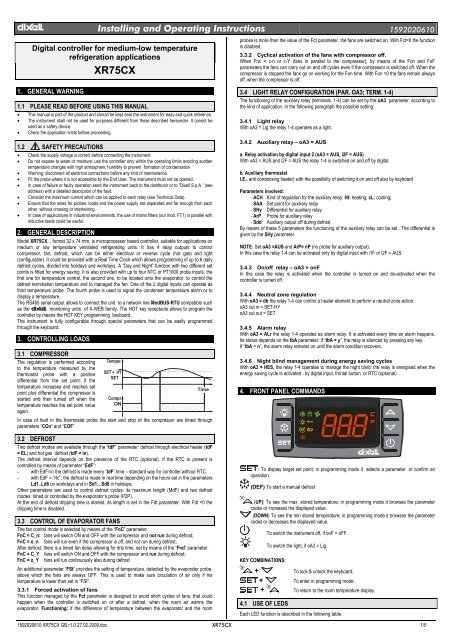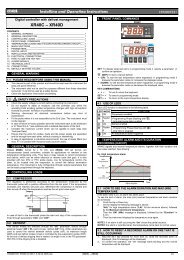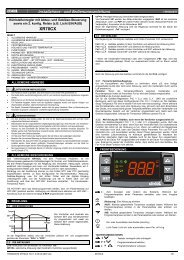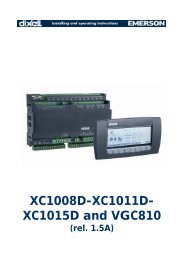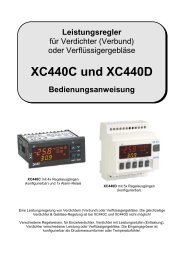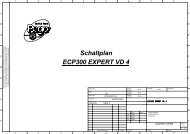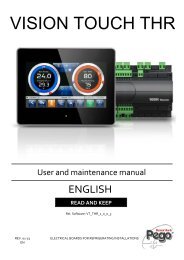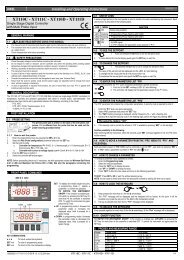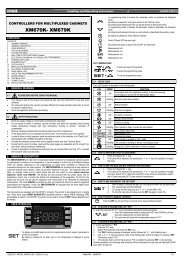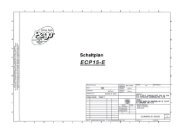XR75CX - Dixell
XR75CX - Dixell
XR75CX - Dixell
Create successful ePaper yourself
Turn your PDF publications into a flip-book with our unique Google optimized e-Paper software.
dIXEL Installing and Operating Instructions 1592020610<br />
Digital controller for medium-low temperature<br />
refrigeration applications<br />
<strong>XR75CX</strong><br />
1. GENERAL WARNING<br />
1.1 PLEASE READ BEFORE USING THIS MANUAL<br />
• This manual is part of the product and should be kept near the instrument for easy and quick reference.<br />
• The instrument shall not be used for purposes different from those described hereunder. It cannot be<br />
used as a safety device.<br />
• Check the application limits before proceeding.<br />
1.2 SAFETY PRECAUTIONS<br />
• Check the supply voltage is correct before connecting the instrument.<br />
• Do not expose to water or moisture: use the controller only within the operating limits avoiding sudden<br />
temperature changes with high atmospheric humidity to prevent formation of condensation<br />
• Warning: disconnect all electrical connections before any kind of maintenance.<br />
• Fit the probe where it is not accessible by the End User. The instrument must not be opened.<br />
• In case of failure or faulty operation send the instrument back to the distributor or to “<strong>Dixell</strong> S.p.A.” (see<br />
address) with a detailed description of the fault.<br />
• Consider the maximum current which can be applied to each relay (see Technical Data).<br />
• Ensure that the wires for probes, loads and the power supply are separated and far enough from each<br />
other, without crossing or intertwining.<br />
• In case of applications in industrial environments, the use of mains filters (our mod. FT1) in parallel with<br />
inductive loads could be useful.<br />
2. GENERAL DESCRIPTION<br />
Model <strong>XR75CX</strong>, , format 32 x 74 mm, is microprocessor based controller, suitable for applications on<br />
medium or low temperature ventilated refrigerating units. It has 4 relay outputs to control<br />
compressor, fan, defrost, which can be either electrical or reverse cycle (hot gas) and light<br />
(configurable). It could be provided with a Real Time Clock which allows programming of up to 6 daily<br />
defrost cycles, divided into holidays and workdays. A “Day and Night” function with two different set<br />
points is fitted for energy saving. It is also provided with up to four NTC or PT1000 probe inputs, the<br />
first one for temperature control, the second one, to be located onto the evaporator, to control the<br />
defrost termination temperature and to managed the fan. One of the 2 digital inputs can operate as<br />
third temperature probe. The fourth probe is used to signal the condenser temperature alarm or to<br />
display a temperature.<br />
The RS485 serial output allows to connect the unit to a network line ModBUS-RTU compatible such<br />
as the dIXEL monitoring units of X-WEB family. The HOT key receptacle allows to program the<br />
controller by means the HOT KEY programming keyboard.<br />
The instrument is fully configurable through special parameters that can be easily programmed<br />
through the keyboard.<br />
3. CONTROLLING LOADS<br />
3.1 COMPRESSOR<br />
The regulation is performed according<br />
to the temperature measured by the<br />
thermostat probe with a positive<br />
differential from the set point: if the<br />
temperature increases and reaches set<br />
point plus differential the compressor is<br />
started and then turned off when the<br />
temperature reaches the set point value<br />
again.<br />
Temper.<br />
SET<br />
Compr.<br />
ON<br />
Time<br />
In case of fault in the thermostat probe the start and stop of the compressor are timed through<br />
parameters “COn” and “COF”.<br />
3.2 DEFROST<br />
Two defrost modes are available through the “tdF” parameter: defrost through electrical heater (tdF<br />
= EL) and hot gas defrost (tdF = in).<br />
The defrost interval depends on the presence of the RTC (optional). If the RTC is present is<br />
controlled by means of parameter “EdF”:<br />
- with EdF=in the defrost is made every “IdF” time – standard way for controller without RTC.<br />
- with EdF = “rtc”, the defrost is made in real time depending on the hours set in the parameters<br />
Ld1..Ld6 on workdays and in Sd1…Sd6 in holidays;<br />
Other parameters are used to control defrost cycles: its maximum length (MdF) and two defrost<br />
modes: timed or controlled by the evaporator’s probe (P2P).<br />
At the end of defrost dripping time is started, its length is set in the Fdt parameter. With Fdt =0 the<br />
dripping time is disabled.<br />
3.3 CONTROL OF EVAPORATOR FANS<br />
The fan control mode is selected by means of the “FnC” parameter:<br />
FnC = C_n: fans will switch ON and OFF with the compressor and not run during defrost;<br />
FnC = o_n fans will run even if the compressor is off, and not run during defrost;<br />
After defrost, there is a timed fan delay allowing for drip time, set by means of the “Fnd” parameter.<br />
FnC = C_Y fans will switch ON and OFF with the compressor and run during defrost;<br />
FnC = o_Y fans will run continuously also during defrost<br />
An additional parameter “FSt” provides the setting of temperature, detected by the evaporator probe,<br />
above which the fans are always OFF. This is used to make sure circulation of air only if his<br />
temperature is lower than set in “FSt”.<br />
3.3.1 Forced activation of fans<br />
This function managed by the Fct parameter is designed to avoid short cycles of fans, that could<br />
happen when the controller is switched on or after a defrost, when the room air warms the<br />
evaporator. Functioning: if the difference of temperature between the evaporator and the room<br />
probes is more than the value of the Fct parameter, the fans are switched on. With Fct=0 the function<br />
is disabled.<br />
3.3.2 Cyclical activation of the fans with compressor off.<br />
When Fnc = c-n or c-Y (fans in parallel to the compressor), by means of the Fon and FoF<br />
parameters the fans can carry out on and off cycles even if the compressor is switched off. When the<br />
compressor is stopped the fans go on working for the Fon time. With Fon =0 the fans remain always<br />
off, when the compressor is off.<br />
3.4 LIGHT RELAY CONFIGURATION (PAR. OA3; TERM. 1-4)<br />
The functioning of the auxiliary relay (terminals. 1-4) can be set by the oA3 parameter, according to<br />
the kind of application. In the following paragraph the possible setting:<br />
3.4.1 Light relay<br />
With oA3 = Lig the relay 1-4 operates as a light.<br />
3.4.2 Auxiliary relay – oA3 = AUS<br />
a. Relay activation by digital input 2 (oA3 = AUS, i2F = AUS)<br />
With oA3 = AUS and i2F = AUS the relay 1-4 is switched on and off by digital.<br />
b. Auxiliary thermostat<br />
I.E.. anti condensing heater) with the possibility of switching it on and off also by keyboard<br />
Parameters involved:<br />
- ACH Kind of regulation for the auxiliary relay: Ht: heating; cL: cooling;<br />
- SAA Set point for auxiliary relay<br />
- SHy Differential for auxiliary relay<br />
- ArP Probe for auxiliary relay<br />
- Sdd Auxiliary output off during defrost<br />
By means of these 5 parameters the functioning of the auxiliary relay can be set.. The differential is<br />
given by the SHy parameter.<br />
NOTE: Set oA3 =AUS and ArP= nP (no probe for auxiliary output).<br />
In this case the relay 1-4 can be activated only by digital input with i1F or i2F = AUS.<br />
3.4.3 On/off relay – oA3 = onF<br />
In this case the relay is activated when the controller is turned on and de-activated when the<br />
controller is turned off.<br />
3.4.4 Neutral zone regulation<br />
With oA3 = db the relay 1-4 can control a heater element to perform a neutral zone action.<br />
oA3 cut in = SET-HY<br />
oA3 cut out = SET<br />
3.4.5 Alarm relay<br />
With oA3 = ALr the relay 1-4 operates as alarm relay. It is activated every time an alarm happens.<br />
Its status depends on the tbA parameter: if “tbA = y”, the relay is silenced by pressing any key.<br />
If “tbA = n”, the alarm relay remains on until the alarm condition recovers.<br />
3.4.6 Night blind management during energy saving cycles<br />
With oA3 = HES, the relay 1-4 operates to manage the night blind: the relay is energised when the<br />
energy saving cycle is activated , by digital input, frontal button or RTC (optional)<br />
4. FRONT PANEL COMMANDS<br />
: To display target set point; in programming mode it selects a parameter or confirm an<br />
operation.<br />
(DEF) To start a manual defrost<br />
(UP): To see the max. stored temperature; in programming mode it browses the parameter<br />
codes or increases the displayed value.<br />
(DOWN) To see the min stored temperature; in programming mode it browses the parameter<br />
codes or decreases the displayed value.<br />
KEY COMBINATIONS:<br />
To switch the instrument off, if onF = oFF.<br />
To switch the light, if oA3 = Lig.<br />
+ To lock & unlock the keyboard.<br />
+ To enter in programming mode.<br />
+ To return to the room temperature display.<br />
4.1 USE OF LEDS<br />
Each LED function is described in the following table.<br />
1592020610 <strong>XR75CX</strong> GB r1.0 27.02.2009.doc <strong>XR75CX</strong> 1/5
dIXEL Installing and Operating Instructions 1592020610<br />
LED MODE FUNCTION<br />
ON Compressor enabled<br />
Flashing Anti-short cycle delay enabled<br />
ON<br />
Defrost enabled<br />
Flashing Drip time in progress<br />
ON<br />
Fans enabled<br />
Flashing Fans delay after defrost in progress.<br />
ON<br />
ON<br />
ON<br />
ON<br />
An alarm is occurring<br />
Continuous cycle is running<br />
Energy saving enabled<br />
Light on<br />
ON Auxiliary relay on<br />
°C/°F ON Measurement unit<br />
°C/°F Flashing Programming phase<br />
5. MAX & MIN TEMPERATURE MEMORIZATION<br />
5.1 HOW TO SEE THE MIN TEMPERATURE<br />
1. Press and release the n key.<br />
2. The “Lo” message will be displayed followed by the minimum temperature recorded.<br />
3. By pressing the n key again or by waiting 5s the normal display will be restored.<br />
5.2 HOW TO SEE THE MAX TEMPERATURE<br />
1. Press and release the o key.<br />
2. The “Hi” message will be displayed followed by the maximum temperature recorded.<br />
3. By pressing the o key again or by waiting 5s the normal display will be restored.<br />
5.3 HOW TO RESET THE MAX AND MIN TEMPERATURE RECORDED<br />
1. Hold press the SET key for more than 3s, while the max. or min temperature is displayed. (rSt<br />
message will be displayed)<br />
2. To confirm the operation the “rSt” message starts blinking and the normal temperature will be<br />
displayed.<br />
6. MAIN FUNCTIONS<br />
6.1 TO SET THE CURRENT TIME AND DAY (ONLY FOR INSTRUMENTS<br />
WITH RTC)<br />
When the instrument is switched on, it’s necessary to program the time and day.<br />
1. Enter the Pr1 programming menu, by pushing the SET + n keys for 3s.<br />
2. The rtc parameter is displayed. Push the SET key to enter the real time clock menu.<br />
3. The Hur (hour) parameter is displayed.<br />
4. Push the SET and set current hour by the UP and Down keys, then push SET to<br />
confirm the value..<br />
5. Repeat the same operations on the Min (minutes) and dAy (day) parameters.<br />
To exit: Push SET+UP keys or wait for 15 sec without pushing any keys.<br />
6.2 HOW TO SEE THE SET POINT<br />
1. Push and immediately release the SET key: the display will show the<br />
Set point value;<br />
2. Push and immediately release the SET key or wait for 5 seconds to<br />
display the probe value again.<br />
6.3 HOW TO CHANGE THE SET POINT<br />
1. Push the SET key for more than 2 seconds to change the Set point value;<br />
2. The value of the set point will be displayed and the “°C” or “°F” LED starts blinking;<br />
3. To change the Set value push the o or n arrows within 10s.<br />
4. To memorise the new set point value push the SET key again or wait 10s.<br />
6.4 HOW TO START A MANUAL DEFROST<br />
Push the DEF key for more than 2 seconds and a manual defrost will start.<br />
6.5 HOW TO CHANGE A PARAMETER VALUE<br />
To change the parameter’s value operate as follows:<br />
1. Enter the Programming mode by pressing the Set + n keys for 3s (the “°C” or “°F” LED starts<br />
blinking).<br />
2. Select the required parameter. Press the “SET” key to display its value<br />
3. Use “UP” or “DOWN” to change its value.<br />
4. Press “SET” to store the new value and move to the following parameter.<br />
To exit: Press SET + UP or wait 15s without pressing a key.<br />
NOTE: the set value is stored even when the procedure is exited by waiting the time-out to expire.<br />
6.6 THE HIDDEN MENU<br />
The hidden menu Includes all the parameters of the instrument.<br />
6.6.1 HOW TO ENTER THE HIDDEN MENU<br />
1. Enter the Programming mode by pressing the Set + n keys for 3s (the “°C” or “°F” LED starts<br />
blinking).<br />
2. Released the keys, then push again the Set+n keys for more than 7s. The Pr2 label will be<br />
displayed immediately followed from the HY parameter.<br />
NOW YOU ARE IN THE HIDDEN MENU.<br />
3. Select the required parameter.<br />
4. Press the “SET” key to display its value<br />
5. Use o or n to change its value.<br />
6. Press “SET” to store the new value and move to the following parameter.<br />
To exit: Press SET + o or wait 15s without pressing a key.<br />
NOTE1: if none parameter is present in Pr1, after 3s the “noP” message is displayed. Keep the keys<br />
pushed till the Pr2 message is displayed.<br />
NOTE2: the set value is stored even when the procedure is exited by waiting the time-out to expire.<br />
6.6.2 HOW TO MOVE A PARAMETER FROM THE HIDDEN MENU TO THE<br />
FIRST LEVEL AND VICEVERSA.<br />
Each parameter present in the HIDDEN MENU can be removed or put into “THE FIRST LEVEL”<br />
(user level) by pressing “SET + n”.<br />
In HIDDEN MENU when a parameter is present in First Level the decimal point is on.<br />
6.7 HOW TO LOCK THE KEYBOARD<br />
1. Keep pressed for more than 3 s the UP + DOWN keys.<br />
2. The “POF” message will be displayed and the keyboard will be locked. At this point it will be<br />
possible only to see the set point or the MAX o Min temperature stored<br />
3. If a key is pressed more than 3s the “POF” message will be displayed.<br />
6.8 TO UNLOCK THE KEYBOARD<br />
Keep pressed together for more than 3s the o and n keys, till the “Pon” message will be<br />
displayed.<br />
6.9 THE CONTINUOUS CYCLE<br />
When defrost is not in progress, it can be activated by holding the “o” key pressed for about 3<br />
seconds. The compressor operates to maintain the “ccS” set point for the time set through the “CCt”<br />
parameter. The cycle can be terminated before the end of the set time using the same activation key<br />
“o” for 3 seconds.<br />
6.10 THE ON/OFF FUNCTION<br />
With “onF = oFF”, pushing the ON/OFF key, the instrument is switched off. The “OFF”<br />
message is displayed. In this configuration, the regulation is disabled.<br />
To switch the instrument on, push again the ON/OFF key.<br />
WARNING: Loads connected to the normally closed contacts of the relays are always<br />
supplied and under voltage, even if the instrument is in stand by mode.<br />
7. PARAMETERS<br />
rtc Real time clock menu (only for controller with RTC): to set the time and date and defrost<br />
start time.<br />
REGULATION<br />
Hy Differential: (0,1 ÷ 25,5°C / 1÷255 °F) Intervention differential for set point. Compressor Cut IN<br />
is Set Point + differential (Hy). Compressor Cut OUT is when the temperature reaches the set<br />
point.<br />
LS Minimum set point: (- 100°C÷SET/-148°F÷SET): Sets the minimum value for the set point.<br />
US Maximum set point: (SET÷110°C/ SET÷230°F). Set the maximum value for set point.<br />
Ot Thermostat probe calibration: (-12.0÷12.0°C; -120÷120°F) allows to adjust possible offset of<br />
the thermostat probe.<br />
P2P Evaporator probe presence: n= not present: the defrost stops by time; y= present: the defrost<br />
stops by temperature.<br />
OE Evaporator probe calibration: (-12.0÷12.0°C; -120÷120°F). allows to adjust possible offset of<br />
the evaporator probe.<br />
P3P Third probe presence (P3): n= not present:, the terminals 18-20 operate as digital input.; y=<br />
present:, the terminals 18-20 operate as third probe.<br />
O3 Third probe calibration (P3): (-12.0÷12.0°C; -120÷120°F). allows to adjust possible offset of<br />
the third probe.<br />
P4P Fourth probe presence: (n = Not present; y = present).<br />
o4 Fourth probe calibration: (-12.0÷12.0°C) allows to adjust possible offset of the fourth probe.<br />
OdS Outputs activation delay at start up: (0÷255min) This function is enabled at the initial start up<br />
of the instrument and inhibits any output activation for the period of time set in the parameter.<br />
AC Anti-short cycle delay: (0÷50 min) minimum interval between the compressor stop and the<br />
following restart.<br />
rtr Percentage of the second and first probe for regulation (0÷100; 100 = P1, 0 = P2 ): it<br />
allows to set the regulation according to the percentage of the first and second probe, as for the<br />
following formula (rtr(P1-P2)/100 + P2).<br />
CCt Compressor ON time during continuous cycle: (0.0÷24.0h; res. 10min) Allows to set the<br />
length of the continuous cycle: compressor stays on without interruption for the CCt time. Can be<br />
used, for instance, when the room is filled with new products.<br />
CCS Set point for continuous cycle: (-100÷150°C) it sets the set point used during the continuous<br />
cycle.<br />
COn Compressor ON time with faulty probe: (0÷255 min) time during which the compressor is<br />
active in case of faulty thermostat probe. With COn=0 compressor is always OFF.<br />
COF Compressor OFF time with faulty probe: (0÷255 min) time during which the compressor is<br />
OFF in case of faulty thermostat probe. With COF=0 compressor is always active.<br />
DISPLAY<br />
CF Temperature measurement unit: °C=Celsius; °F=Fahrenheit. WARNING: When the<br />
measurement unit is changed the SET point and the values of the parameters Hy, LS, US, Ot,<br />
ALU and ALL have to be checked and modified if necessary).<br />
rES Resolution (for °C): (in = 1°C; dE = 0.1 °C) allows decimal point display.<br />
Lod Instrument display: (P1; P2, P3, P4, SET, dtr): it selects which probe is displayed by the<br />
instrument: P1 = Thermostat probe; P2 = Evaporator probe; P3 = Third probe(only for model<br />
with this option enabled); P4 = Fourth probe, SET = set point; dtr = percentage of<br />
visualization.<br />
rEd X- REP display (optional): (P1; P2, P3, P4, SET, dtr): it selects which probe is displayed by<br />
X- REP: P1 = Thermostat probe; P2 = Evaporator probe; P3 = Third probe(only for model with<br />
this option enabled); P4 = Fourth probe, SET = set point; dtr = percentage of visualization.<br />
dLy Display delay: (0 ÷20.0m; resul. 10s) when the temperature increases, the display is updated<br />
of 1 °C/1°F after this time.<br />
1592020610 <strong>XR75CX</strong> GB r1.0 27.02.2009.doc <strong>XR75CX</strong> 2/5
dIXEL Installing and Operating Instructions 1592020610<br />
dtr Percentage of the second and first probe for visualization when Lod = dtr (0÷100; 100 =<br />
P1, 0 = P2 ): if Lod = dtr it allows to set the visualization according to the percentage of the<br />
first and second probe, as for the following formula (dtr(P1-P2)/100 + P2).<br />
DEFROST<br />
EdF Defrost mode (only for controller with RTC):<br />
rtc = Real Time Clock mode. Defrost time follows Ld1÷Ld6 parameters on workdays and<br />
Sd1÷Sd6 on holidays.<br />
in = interval mode. The defrost starts when the time “Idf” is expired.<br />
tdF Defrost type: EL = electrical heater; in = hot gas<br />
dFP Probe selection for defrost termination: nP = no probe; P1 =thermostat probe; P2 =<br />
evaporator probe; P3 =configurable probe; P4 = Probe on Hot Key plug.<br />
dtE Defrost termination temperature: (-50÷50 °C/<br />
-58÷122°F) (Enabled only when EdF=Pb) sets the temperature measured by the evaporator<br />
probe, which causes the end of defrost.<br />
IdF<br />
Interval between defrost cycles: (0÷120h) Determines the time interval between the<br />
beginning of two defrost cycles.<br />
MdF (Maximum) length for defrost: (0÷255min) When P2P = n, (not evaporator probe: timed<br />
defrost) it sets the defrost duration, when P2P = y (defrost end based on temperature) it sets<br />
the maximum length for defrost.<br />
dSd Start defrost delay: ( 0÷99min) This is useful when different defrost start times are necessary<br />
to avoid overloading the plant.<br />
dFd Temperature displayed during defrost: (rt = real temperature; it = temperature at defrost<br />
start; SEt = set point; dEF = “dEF” label)<br />
dAd MAX display delay after defrost: (0÷255min). Sets the maximum time between the end of<br />
defrost and the restarting of the real room temperature display.<br />
Fdt Drip time: (0÷120 min) time interval between reaching defrost termination temperature and the<br />
restoring of the control’s normal operation. This time allows the evaporator to eliminate water<br />
drops that might have formed due to defrost.<br />
dPo First defrost after start-up: (y = immediately; n = after the IdF time)<br />
dAF Defrost delay after continuous cycle: (0÷23.5h) time interval between the end of the fast<br />
freezing cycle and the following defrost related to it.<br />
FANS<br />
FnC Fans operating mode: C-n= runs with the compressor, OFF during defrost;<br />
o-n = continuous mode, OFF during defrost;<br />
C-Y = runs with the compressor, ON during defrost;<br />
o-Y = continuous mode, ON during defrost;<br />
Fnd Fans delay after defrost: (0÷255min) Interval between end of defrost and evaporator fans<br />
start.<br />
Fct Temperature differential avoiding short cycles of fans (0÷59°C; Fct=0 function disabled). If<br />
the difference of temperature between the evaporator and the room probes is more than the<br />
value of the Fct parameter, the fans are switched on.<br />
FSt Fans stop temperature: (-50÷50°C/122°F) setting of temperature, detected by evaporator<br />
probe, above which fans are always OFF.<br />
Fon Fan ON time: (0÷15 min) with Fnc = C_n or C_y, (fan activated in parallel with compressor). it<br />
sets the evaporator fan ON cycling time when the compressor is off. With Fon =0 and FoF ≠ 0<br />
the fan are always off, with Fon=0 and FoF =0 the fan are always off.<br />
FoF Fan OFF time: (0÷15 min) with Fnc = C_n or C_y, (fan activated in parallel with compressor). it<br />
sets the evaporator fan off cycling time when the compressor is off. With Fon =0 and FoF ≠ 0<br />
the fan are always off, with Fon=0 and FoF =0 the fan are always off.<br />
FAP Probe selection for fan management: nP = no probe; P1 =thermostat probe; P2 = evaporator<br />
probe; P3 =configurable probe; P4 = Probe on Hot Key plug.<br />
AUXILIARY THERMOSTAT CONFIGURATION (terms. 1-4) – OA3 = AUS<br />
ACH Kind of regulation for auxiliary relay: Ht = heating; CL = cooling<br />
SAA Set Point for auxiliary relay: (-100÷150°C; -148÷302°F) it defines the room temperature set<br />
point to switch auxiliary relay.<br />
SHy Differential for auxiliary output: (0,1 ÷ 25,5°C / 1÷255 °F) Intervention differential for<br />
auxiliary output set point.<br />
With ACH = cL AUX Cut in is SAA + SHy; . AUX Cut out is SAA<br />
With ACH = Ht AUX Cut in is SAA - SHy; . AUX Cut out is SAA<br />
ArP Probe selection for auxiliary: nP = no probe, the auxiliary relay is switched only by the digital<br />
input; P1 = Probe 1 (Thermostat probe); P2 = Probe 2 (evaporator probe); P3 = Probe 3<br />
(display probe); P4 = Probe 4.<br />
Sdd Auxiliary relay off during defrost: n = the auxiliary relay operates during defrost.<br />
y = the auxiliary relay is switched off during defrost.<br />
ALARMS<br />
ALP Probe selection for alarm: nP = no probe, the temperature alarms are disabled; P1 = Probe 1<br />
(Thermostat probe); P2 = Probe 2 (evaporator probe); P3 = Probe 3 (display probe); P4 =<br />
Fourth probe.<br />
ALC Temperature alarms configuration: (Ab; rE)<br />
Ab= absolute temperature: alarm temperature is given by the ALL or ALU values. rE =<br />
temperature alarms are referred to the set point. Temperature alarm is enabled when the<br />
temperature exceeds the “SET+ALU” or “SET-ALL” values.<br />
ALU MAXIMUM temperature alarm: (SET÷150°C; SET÷302°F) when this temperature is reached<br />
the alarm is enabled, after the “ALd” delay time.<br />
ALL Minimum temperature alarm: (-100 ÷ SET °C; -148÷230°F when this temperature is reached<br />
the alarm is enabled, after the “ALd” delay time.<br />
AFH Differential for temperature alarm/ fan recovery: (0,1÷25,5°C; 1÷45°F) Intervention<br />
differential for recovery of temperature alarm. It’s also used for the restart of the fan when the<br />
FSt temperature is reached<br />
ALd Temperature alarm delay: (0÷255 min) time interval between the detection of an alarm<br />
condition and alarm signalling.<br />
dAO Exclusion of temperature alarm at start-up: (from 0.0 min to 23.5h) time interval between the<br />
detection of the temperature alarm condition after instrument power on and alarm signalling.<br />
CONDENSER TEMPERATURE ALARM<br />
AP2 Probe selection for temperature alarm of condenser: nP = no probe; P1 =thermostat probe;<br />
P2 = evaporator probe; P3 =configurable probe; P4 = Probe on Hot Key plug.<br />
AL2 Low temperature alarm of condenser: (-100÷150°C) when this temperature is reached the<br />
LA2 alarm is signalled, possibly after the Ad2 delay.<br />
Au2 High temperature alarm of condenser: (-100÷150°C) when this temperature is reached the<br />
HA2 alarm is signalled, possibly after the Ad2 delay.<br />
AH2 Differential for temperature condenser alarm recovery: (0,1÷25,5°C; 1÷45°F)<br />
Ad2 Condenser temperature alarm delay: (0÷255 min) time interval between the detection of the<br />
condenser alarm condition and alarm signalling.<br />
dA2 Condenser temperature alarm exclusion at start up: (from 0.0 min to 23.5h, res. 10min)<br />
bLL Compressor off with low temperature alarm of condenser: n = no: compressor keeps on<br />
working; Y = yes, compressor is switched off till the alarm is present, in any case regulation<br />
restarts after AC time at minimum.<br />
AC2 Compressor off with high temperature alarm of condenser: n = no: compressor keeps on<br />
working; Y = yes, compressor is switched off till the alarm is present, in any case regulation<br />
restarts after AC time at minimum.<br />
AUXILIARY RELAY<br />
tbA Alarm relay silencing (with oA3 =ALr):<br />
n= silencing disabled: alarm relay stays on till alarm condition lasts,<br />
y =silencing enabled: alarm relay is switched OFF by pressing a key during an alarm<br />
oA3 Fourth relay configuration (1-4): dEF, FAn: do not select it!. ALr: alarm; Lig: light; AuS:<br />
Auxiliary relay; onF: always on with instrument on; db= neutral zone; cP2 = do not select it!;<br />
dEF2: do not select it!;. HES:. night blind<br />
AoP Alarm relay polarity: it set if the alarm relay is open or closed when an alarm happens. CL=<br />
terminals 1-4 closed during an alarm; oP = terminals 1-4 open during an alarm<br />
DIGITAL INPUTS<br />
i1P Digital input polarity (18-20): oP: the digital input is activated by opening the contact; CL: the<br />
digital input is activated by closing the contact.<br />
i1F Digital input configuration (18-20): dor= door switch function; dEF= activation of a defrost<br />
cycle;<br />
i2P<br />
2 nd digital input polarity (18-19): oP: the digital input is activated by opening the contact; CL:<br />
the digital input is activated by closing the contact.<br />
i2F 2 nd digital input configuration (18-19): EAL= external alarm: “EA” message is displayed;<br />
bAL= serious alarm “CA” message is displayed. PAL= pressure switch alarm, “CA” message is<br />
displayed; dor= door switch function; dEF= activation of a defrost cycle; ES = energy saving;<br />
AUS=auxiliary relay activation with 0A3 = AUS; Htr= kind of action inversion (cooling –<br />
heating); FAn= fan; HdF = Holiday defrost (enable only with RTC); onF = to switch the<br />
controller off.<br />
did (0÷255 min) with i2F= EAL or i2F = bAL digital input alarm delay (18-20): delay between the<br />
detection of the external alarm condition and its signalling.<br />
with i2F= PAL: time for pressure switch function: time interval to calculate the number of<br />
the pressure switch activation.<br />
doA Door open signalling delay (0÷255 min):<br />
nPS Pressure switch number: (0 ÷15) Number of activation of the pressure switch, during the “did”<br />
interval, before signalling the alarm event (I2F= PAL).<br />
If the nPS activation in the did time is reached, switch off and on the instrument to<br />
restart normal regulation.<br />
odc Compressor and fan status when open door: no = normal; Fan = Fan OFF; CPr =<br />
Compressor OFF; F_C = Compressor and fan OFF.<br />
rrd<br />
Outputs restart after doA alarm: no= outputs not affected by the doA alarm; yES = outputs<br />
restart with the doA alarm.<br />
HES Temperature increase during the Energy Saving cycle:<br />
(-30,0°C÷30,0°C) it sets the increasing value of the set point during the Energy Saving cycle.<br />
TO SET CURRENT TIME AND WEEKLY HOLIDAYS (ONLY FOR MODELS WITH RTC)<br />
Hur Current hour (0 ÷ 23 h)<br />
Min Current minute (0 ÷ 59min)<br />
dAY Current day (Sun ÷ SAt)<br />
Hd1 First weekly holiday (Sun ÷ nu) Set the first day of the week which follows the holiday<br />
times.<br />
Hd2 Second weekly holiday (Sun ÷ nu) Set the second day of the week which follows the<br />
holiday times.<br />
N.B. Hd1,Hd2 can be set also as “nu” value (Not Used).<br />
TO SET ENERGY SAVING TIMES (ONLY FOR MODELS WITH RTC)<br />
ILE Energy Saving cycle start during workdays: (0 ÷ 23h 50 min.) During the Energy Saving<br />
cycle the set point is increased by the value in HES so that the operation set point is SET +<br />
HES.<br />
dLE Energy Saving cycle length during workdays: (0 ÷ 24h 00 min.) Sets the duration of the<br />
Energy Saving cycle on workdays.<br />
ISE Energy Saving cycle start on holidays. (0 ÷ 23h 50 min.)<br />
dSE Energy Saving cycle length on holidays (0 ÷ 24h 00 min.)<br />
TO SET DEFROST TIMES (ONLY FOR MODELS WITH RTC)<br />
Ld1÷Ld6 Workday defrost start (0 ÷ 23h 50 min.) These parameters set the beginning of the 6<br />
programmable defrost cycles during workdays. Ex. When Ld2 = 12.4 the second defrost starts<br />
at 12.40 during workdays.<br />
Sd1÷Sd6 Holiday defrost start (0 ÷ 23h 50 min.) These parameters set the beginning of the 6<br />
programmable defrost cycles on holidays. Ex. When Sd2 = 3.4 the second defrost starts at<br />
3.40 on holidays.<br />
N.B. :To disable a defrost cycle set it to “nu”(not used). Ex. If Ld6=nu ; the sixth defrost<br />
cycle is disabled<br />
OTHER<br />
Adr Serial address (1÷244): Identifies the instrument address when connected to a ModBUS<br />
compatible monitoring system.<br />
PbC Type of probe: it allows to set the kind of probe used by the instrument: Pt1 = Pt1000 probe,<br />
ntc = NTC probe.<br />
onF on/off key enabling: nu = disabled; oFF = enabled; ES = not set it.<br />
dP1 Thermostat probe display<br />
dP2 Evaporator probe display<br />
dP3 Third probe display- optional.<br />
dP4 Fourth probe display.<br />
rSE Real set point: it shows the set point used during the energy saving cycle or during the<br />
continuous cycle.<br />
rEL Software release for internal use.<br />
Ptb Parameter table code: readable only.<br />
1592020610 <strong>XR75CX</strong> GB r1.0 27.02.2009.doc <strong>XR75CX</strong> 3/5
dIXEL Installing and Operating Instructions 1592020610<br />
8. DIGITAL INPUTS<br />
The first digital input 18-20 is enabled with P3P = n.<br />
With P3P = n and i1F = i2F the second digital input is disabled<br />
The free voltage digital inputs are programmable by the “i1F” and i2F parameters.<br />
8.1 GENERIC ALARM (i2F = EAL)<br />
As soon as the digital input is activated the unit will wait for “did” time delay before signalling the<br />
“EAL” alarm message. The outputs status don’t change. The alarm stops just after the digital input is<br />
de-activated.<br />
8.2 SERIOUS ALARM MODE (i2F = bAL)<br />
When the digital input is activated, the unit will wait for “did” delay before signalling the “CA” alarm<br />
message. The relay outputs are switched OFF. The alarm will stop as soon as the digital input is deactivated.<br />
8.3 PRESSURE SWITCH (i2F = PAL)<br />
If during the interval time set by “did” parameter, the pressure switch has reached the number of<br />
activation of the “nPS” parameter, the “CA” pressure alarm message will be displayed. The<br />
compressor and the regulation are stopped. When the digital input is ON the compressor is always<br />
OFF. If the nPS activation in the did time is reached, switch off and on the instrument to<br />
restart normal regulation.<br />
8.4 DOOR SWITCH INPUT (i1F or i2F = dor)<br />
It signals the door status and the corresponding relay output status through the “odc” parameter: no<br />
= normal (any change); Fan = Fan OFF; CPr = Compressor OFF; F_C = Compressor and fan OFF.<br />
Since the door is opened, after the delay time set through parameter “doA”, the door alarm is<br />
enabled, the display shows the message “dA” and the regulation restarts is rtr = yES. The alarm<br />
stops as soon as the external digital input is disabled again. With the door open, the high and low<br />
temperature alarms are disabled.<br />
8.5 START DEFROST (i1F or i2F = dEF)<br />
It starts a defrost if there are the right conditions. After the defrost is finished, the normal regulation<br />
will restart only if the digital input is disabled otherwise the instrument will wait until the “MdF” safety<br />
time is expired.<br />
8.6 SWITCH THE AUXILIARY RELAY (i2F = AUS)<br />
With oA3 = AUS the digital input switched the status of the auxiliary relay<br />
8.7 INVERSION OF THE KIND OF ACTION: HEATING-COOLING (i2F=Htr)<br />
This function allows to invert the regulation of the controller: from cooling to heating and viceversa.<br />
8.8 ENERGY SAVING (i2F = ES)<br />
The Energy Saving function allows to change the set point value as the result of the SET+ HES<br />
(parameter) sum. This function is enabled until the digital input is activated.<br />
8.9 HOLIDAY DEFROST (i2F = HDF) –ONLY FOR MODELS WITH RTC<br />
This function enabled the holiday defrost setting.<br />
8.10 ON OFF FUNCTION (i2F = onF)<br />
To switch the controller on and off.<br />
8.11 DIGITAL INPUTS POLARITY<br />
The digital input polarity depends on the “i1P” and “i2P” parameters.<br />
i1P or i2P =CL: the input is activated by closing the contact.<br />
i1P or i2P=OP: the input is activated by opening the contact<br />
9. RS485 SERIAL LINE – FOR MONITORING SYSTEMS<br />
The RS485 serial line, allows to connect the instrument to a monitoring system ModBUS-RTU<br />
compatible such as the X-WEB500/3000/300.<br />
10. X-REP OUTPUT – OPTIONAL<br />
As optional, an X-REP can be connected to the instrument, trough the dedicated<br />
connector.<br />
To connect the X-REP to the<br />
instrument the following connectors<br />
must be used CAB-51F(1m), CAB-<br />
52F(2m), CAB-55F(5m),<br />
11. INSTALLATION AND MOUNTING<br />
Instrument <strong>XR75CX</strong> shall be mounted on vertical panel, in a<br />
29x71 mm hole, and fixed using the special bracket supplied.<br />
The temperature range allowed for correct operation is 0÷60 °C.<br />
Avoid places subject to strong vibrations, corrosive gases,<br />
excessive dirt or humidity. The same recommendations apply to<br />
probes. Let air circulate by the cooling holes.<br />
12. ELECTRICAL CONNECTIONS<br />
The instrument is provided with screw terminal block to connect cables with a cross section up to 2,5<br />
mm 2 . Before connecting cables make sure the power supply complies with the instrument’s<br />
requirements. Separate the probe cables from the power supply cables, from the outputs and the<br />
power connections. Do not exceed the maximum current allowed on each relay, in case of heavier<br />
loads use a suitable external relay.<br />
12.1 PROBE CONNECTION<br />
The probes shall be mounted with the bulb upwards to prevent damages due to casual liquid<br />
infiltration. It is recommended to place the thermostat probe away from air streams to correctly<br />
measure the average room temperature. Place the defrost termination probe among the evaporator<br />
fins in the coldest place, where most ice is formed, far from heaters or from the warmest place during<br />
defrost, to prevent premature defrost termination.<br />
13. HOW TO USE THE HOT KEY<br />
13.1 HOW TO PROGRAM A HOT KEY FROM THE INSTRUMENT (UPLOAD)<br />
1. Program one controller with the front keypad.<br />
2. When the controller is ON, insert the “Hot key” and push o key; the "uPL" message<br />
appears followed a by flashing “End”<br />
3. Push “SET” key and the End will stop flashing.<br />
4. Turn OFF the instrument remove the “Hot Key”, then turn it ON again.<br />
NOTE: the “Err” message is displayed for failed programming. In this case push again o key if you<br />
want to restart the upload again or remove the “Hot key” to abort the operation.<br />
13.2 HOW TO PROGRAM AN INSTRUMENT USING A HOT KEY<br />
(DOWNLOAD)<br />
1. Turn OFF the instrument.<br />
2. Insert a programmed “Hot Key” into the 5 PIN receptacle and then turn the Controller ON.<br />
3. Automatically the parameter list of the “Hot Key” is downloaded into the Controller memory,<br />
the “doL” message is blinking followed a by flashing “End”.<br />
4. After 10 seconds the instrument will restart working with the new parameters.<br />
5. Remove the “Hot Key”..<br />
NOTE the message “Err” is displayed for failed programming. In this case turn the unit off and then<br />
on if you want to restart the download again or remove the “Hot key” to abort the operation.<br />
14. ALARM SIGNALS<br />
Message Cause Outputs<br />
“P1” Room probe failure Compressor output acc. to par. “Con” and “COF”<br />
“P2” Evaporator probe failure Defrost end is timed<br />
“P3” Third probe failure Outputs unchanged<br />
“P4” Fourth probe failure Outputs unchanged<br />
“HA” Maximum temperature alarm Outputs unchanged.<br />
“LA” Minimum temperature alarm Outputs unchanged.<br />
"HA2" Condenser high temperature It depends on the “Ac2” parameter<br />
"LA2" Condenser low temperature It depends on the “bLL” parameter<br />
“dA” Door open Compressor and fans restarts<br />
“EA” External alarm Output unchanged.<br />
“CA” Serious external alarm (i1F=bAL) All outputs OFF.<br />
“CA” Pressure switch alarm (i1F=PAL) All outputs OFF<br />
“rtc” Real time clock alarm Alarm output ON; Other outputs unchanged;<br />
Defrosts according to par. “IdF” Set real time clock<br />
has to be set<br />
rtF Real time clock board failure Alarm output ON; Other outputs unchanged;<br />
Defrosts according to par. “IdF” Contact the<br />
service<br />
14.1 SILENCING BUZZER / ALARM RELAY OUTPUT<br />
If “tbA = y”, the buzzer and the relay are is silenced by pressing any key.<br />
If “tbA = n”, only the buzzer is silenced while the alarm relay is on until the alarm condition recovers.<br />
14.2 ALARM RECOVERY<br />
Probe alarms P1”, “P2”, “P3” and “P4” start some seconds after the fault in the related probe; they<br />
automatically stop some seconds after the probe restarts normal operation. Check connections<br />
before replacing the probe.<br />
Temperature alarms “HA”, “LA” “HA2” and “LA2” automatically stop as soon as the temperature<br />
returns to normal values.<br />
Alarms “EA” and “CA” (with i1F=bAL) recover as soon as the digital input is disabled.<br />
Alarm “CA” (with i1F=PAL) recovers only by switching off and on the instrument.<br />
To connect 14.3 the OTHER X-REP to MESSAGES the<br />
instrument Pon the following Keyboard unlocked. connectors<br />
must be<br />
PoF<br />
used CAB/REP1(1m),<br />
Keyboard locked<br />
CAB/REP2 (2m), CAB/REP5 (5m),<br />
noP In programming mode: none parameter is present in Pr1<br />
On the display or in dP2, dP3, dP4: the selected probe is nor enabled<br />
15. TECHNICAL DATA<br />
Housing: self extinguishing ABS.<br />
Case: frontal 32x74 mm; depth 60mm;<br />
Mounting: panel mounting in a 71x29mm panel cut-out<br />
Protection: IP20; Frontal protection: IP65<br />
Connections: Screw terminal block ≤ 2,5 mm 2 wiring.<br />
Power supply: according to the model 24Vac, ±10%; 230Vac ±10%, 50/60Hz, 110Vac ±10%,<br />
50/60Hz<br />
Power absorption: 3VA max<br />
Display: 3 digits, red LED, 14,2 mm high; Inputs: Up to 4 NTC or PT1000 probes.<br />
Digital inputs: free voltage contact<br />
Relay outputs: compressor SPST 8(3) A, 250Vac or SPST 16A 250Vac<br />
defrost: SPDT 8(3) A, 250Vac<br />
fan: SPST 5A, 250Vac<br />
aux: SPDT 8(3) A, 250Vac or SPST 16(6)A 250Vac<br />
Data storing: on the non-volatile memory (EEPROM).<br />
Internal clock back-up: 24 hours<br />
Kind of action: 1B; Pollution grade: 2;Software class: A.;<br />
1592020610 <strong>XR75CX</strong> GB r1.0 27.02.2009.doc <strong>XR75CX</strong> 4/5
dIXEL Installing and Operating Instructions 1592020610<br />
Rated impulsive voltage: 2500V; Overvoltage Category: II<br />
Operating temperature: 0÷55°C; Storage temperature: -30÷85 °C.<br />
Relative humidity: 20÷85% (no condensing)<br />
Measuring and regulation range: NTC probe: -40÷110°C (-40÷230°F);<br />
PT1000 probe: -100÷150°C (-148÷302°F)<br />
Resolution: 0,1 °C or 1°C or 1 °F (selectable); Accuracy (ambient temp. 25°C): ±0,7 °C ±1 digit<br />
16. CONNECTIONS<br />
Supply: 120Vac or 24Vac: connect to terminals 5-6.<br />
The X-REP output is optional<br />
17. DEFAULT SETTING VALUES<br />
Label Name Range Value Level<br />
Set Set point LS÷US -5.0 - - -<br />
rtc* Real time clock menu - - Pr1<br />
Hy Differential 0,1÷25.5°C/ 1÷ 255°F 2.0 Pr1<br />
LS Minimum set point -100C÷SET/-58°F÷SET -50.0 Pr2<br />
US Maximum set point SET÷110°C/ SET ÷ 230°F 110 Pr2<br />
Ot Thermostat probe calibration -12÷12°C /-120÷120°F 0.0 Pr1<br />
P2P Evaporator probe presence n=not present; Y=pres. Y Pr1<br />
OE Evaporator probe calibration -12÷12°C /-120÷120°F 0.0 Pr2<br />
P3P Third probe presence n=not present; Y=pres. n Pr2<br />
O3 Third probe calibration -12÷12°C /-120÷120°F 0 Pr2<br />
P4P Fourth probe presence n=not present; Y=pres. n Pr2<br />
O4 Fourth probe calibration -12÷12°C /-120÷120°F 0 Pr2<br />
OdS Outputs delay at start up 0÷255 min 0 Pr2<br />
AC Anti-short cycle delay 0 ÷ 50 min 1 Pr1<br />
rtr P1-P2 percentage for regulation 0 ÷ 100 (100=P1 , 0=P2) 100 Pr2<br />
CCt Continuous cycle duration 0.0÷24.0h 0.0 Pr2<br />
CCS Set point for continuous cycle (-100÷150,0°C) (-67÷302°F) -5 Pr2<br />
COn Compressor ON time with faulty probe 0 ÷ 255 min 15 Pr2<br />
COF Compressor OFF time with faulty probe 0 ÷ 255 min 30 Pr2<br />
CF Temperature measurement unit °C ÷ °F °C Pr2<br />
rES Resolution in=integer; dE= dec.point dE Pr1<br />
Lod Probe displayed P1;P2 P1 Pr2<br />
rEd 2 X-REP display P1 – P2 – P3 – P4 – SEt – dtr P1 Pr2<br />
dLy Display temperature delay 0 ÷ 20.0 min (10 sec.) 0.0 Pr2<br />
dtr P1-P2 percentage for display 1 ÷ 99 50 Pr2<br />
EdF* Kind of interval for defrost rtc ÷in rtc Pr2<br />
tdF Defrost type EL=el. heater; in= hot gas EL Pr1<br />
dFP Probe selection for defrost termination nP; P1; P2; P3; P4 P2 Pr2<br />
dtE Defrost termination temperature -50 ÷ 50 °C 8 Pr1<br />
IdF Interval between defrost cycles 1 ÷ 120 ore 6 Pr1<br />
MdF (Maximum) length for defrost 0 ÷ 255 min 30 Pr1<br />
dSd Start defrost delay 0÷99min 0 Pr2<br />
dFd Displaying during defrost rt, it, SEt, DEF it Pr2<br />
dAd MAX display delay after defrost 0 ÷ 255 min 30 Pr2<br />
Fdt Draining time 0÷120 min 0 Pr2<br />
dPo First defrost after start-up n=after IdF; y=immed. n Pr2<br />
dAF Defrost delay after fast freezing 0 ÷ 23h e 50’ 0.0 Pr2<br />
Fnc Fan operating mode C-n, o-n, C-y, o-Y o-n Pr1<br />
Fnd Fan delay after defrost 0÷255min 10 Pr1<br />
Fct Differential of temperature for forced<br />
0÷50°C<br />
activation of fans<br />
10 Pr2<br />
FSt Fan stop temperature -50÷50°C/-58÷122°F 2 Pr1<br />
Fon Fan on time with compressor off 0÷15 (min.) 0 Pr2<br />
FoF Fan off time with compressor off 0÷15 (min.) 0 Pr2<br />
FAP Probe selection for fan management nP; P1; P2; P3; P4 P2 Pr2<br />
ACH Kind of action for auxiliary relay CL; Ht cL Pr2<br />
SAA Set Point for auxiliary relay -100÷110°C / -58÷230°F 0,0 Pr2<br />
SHy Differential for auxiliary relay 0,1÷25.5°C/ 1÷ 255°F 2,0 Pr2<br />
ArP Probe selection for auxiliary relay nP / P1 / P2 / P3/P4 nP Pr2<br />
Sdd Auxiliary relay operating during defrost n÷y n Pr2<br />
ALP Alarm probe selection nP; P1; P2; P3; P4 P1 Pr2<br />
ALc Temperat. alarms configuration<br />
rE= related to set;<br />
Ab = absolute<br />
Ab Pr2<br />
ALU MAXIMUM temperature alarm Set÷110.0°C; Set÷230°F 110,0 Pr1<br />
ALL Minimum temperature alarm -100°C÷Set/ -58°F÷Set -50,0 Pr1<br />
AFH Differential for temperat. alarm recovery (0,1°C÷25,5°C) (1°F÷45°F) 2,0 Pr2<br />
ALd Temperature alarm delay 0 ÷ 255 min 15 Pr2<br />
dAO Delay of temperature alarm at start up 0 ÷ 23h e 50’ 1,3 Pr2<br />
Label Name Range Value Level<br />
AP2 Probe for temperat. alarm of condenser nP; P1; P2; P3; P4 P4 Pr2<br />
AL2 Condenser for low temperat. alarm (-100 ÷ 150°C) (-67÷ 302°F) -40 Pr2<br />
AU2 Condenser for high temperat. alarm (-100 ÷ 150°C) (-67÷ 302°F) 110 Pr2<br />
AH2 Differ. for condenser temp. alar. recovery [0,1°C ÷ 25,5°C] [1°F ÷ 45°F] 5 Pr2<br />
Ad2 Condenser temperature alarm delay 0 ÷ 254 (min.) , 255=nU 15 Pr2<br />
dA2 Delay of cond. temper. alarm at start up 0.0 ÷ 23h 50’ 1,3 Pr2<br />
Compr. off for condenser low<br />
bLL temperature alarm<br />
n(0) - Y(1)<br />
n Pr2<br />
Compr. off for condenser high<br />
AC2 temperature alarm<br />
n(0) - Y(1)<br />
n Pr2<br />
tbA Alarm relay disabling n=no; y=yes y Pr2<br />
oA3 Fourth relay configuration<br />
ALr = alarm; dEF = do not select<br />
it; Lig =Light; AUS =AUX;<br />
onF=always on; Fan= do not<br />
select it; db = neutral zone; cP2<br />
Lig Pr2<br />
= second compressor; dF2 = do<br />
not select it; HES = night blind<br />
AoP Alarm relay polarity (oA3=ALr) oP; cL cL Pr2<br />
i1P Digital input polarity (18-20) oP=opening;CL=closing cL Pr1<br />
i1F Digital input 1 configuration (18-20) dor; dEF; dor Pr1<br />
i2P Digital input polarity (18-19) oP=opening;CL=closing cL Pr2<br />
i2F Digital input configuration (18-19) EAL - bAL- PAL - dor - dEF -<br />
ES - AUS - Htr - FAn - HdF - EAL Pr2<br />
onF<br />
did Digital input alarm delay (18-20) 0÷255min 15 Pr1<br />
doA Door open alarm delay 0÷255min 15 Pr1<br />
Nps Number of activation of pressure switch 0 ÷15 15 Pr2<br />
odc Compress and fan status when open no; Fan; CPr; F_C<br />
door<br />
F-c Pr2<br />
rrd Regulation restart with door open alarm n – Y y Pr2<br />
HES Differential for Energy Saving (-30°C÷30°C) (-54°F÷54°F) 0 Pr2<br />
Hur* Current hour 0 ÷ 23 - Pr1<br />
Min* Current minute 0 ÷ 59 - Pr1<br />
dAY* Current day Sun ÷ SAt - Pr1<br />
Hd1* First weekly holiday Sun÷ SAt – nu nu Pr1<br />
Hd2* Second weekly holiday Sun÷ SAt – nu nu Pr1<br />
ILE* Energy Saving cycle start during 0 ÷ 23h 50 min.<br />
workdays<br />
0.0 Pr1<br />
dLE* Energy Saving cycle length during 0 ÷ 24h 00 min.<br />
workdays<br />
0 Pr1<br />
ISE* Energy Saving cycle start on holidays 0 ÷ 23h 50 min. 0.0 Pr1<br />
dSE* Energy Saving cycle length on holidays 0 ÷ 24h 00 min. 0 Pr1<br />
Ld1* 1 st workdays defrost start 0 ÷ 23h 50 min. - nu 6.0 Pr1<br />
Ld2* 2 nd workdays defrost start 0 ÷ 23h 50 min. - nu 13.0 Pr1<br />
Ld3* 3 rd workdays defrost start 0 ÷ 23h 50 min. - nu 21.0 Pr1<br />
Ld4* 4 th workdays defrost start 0 ÷ 23h 50 min. - nu nu Pr1<br />
Ld5* 5 th workdays defrost start 0 ÷ 23h 50 min. - nu nu Pr1<br />
Ld6* 6 th workdays defrost start 0 ÷ 23h 50 min. - nu nu Pr1<br />
Sd1* 1 st holiday defrost start 0 ÷ 23h 50 min. - nu 6.0 Pr1<br />
Sd2* 2 nd holiday defrost start 0 ÷ 23h 50 min. - nu 13.0 Pr1<br />
Sd3* 3 rd holiday defrost start 0 ÷ 23h 50 min. - nu 21.0 Pr1<br />
Sd4* 4 th holiday defrost start 0 ÷ 23h 50 min. - nu nu Pr1<br />
Sd5* 5 th holiday defrost start 0 ÷ 23h 50 min. - nu nu Pr1<br />
Sd6* 6 th holiday defrost start 0 ÷ 23h 50 min. - nu nu Pr1<br />
Adr Serial address 1÷247 1 Pr2<br />
PbC Kind of probe Pt1000; ntc ntc Pr2<br />
onF on/off key enabling nu, oFF; ES nu Pr2<br />
dP1 Room probe display -- - Pr1<br />
dP2 Evaporator probe display -- - Pr1<br />
dP3 Third probe display -- - Pr1<br />
dP4 Fourth probe display -- - Pr1<br />
rSE Real set actual set - Pr2<br />
rEL Software release -- 2.6 Pr2<br />
Ptb Map code -- - Pr2<br />
* Only for model with real time clock<br />
2<br />
Only for <strong>XR75CX</strong> with X-REP output<br />
<strong>Dixell</strong> S.p.A. Z.I. Via dell’Industria, 27<br />
32010 Pieve d’Alpago (BL) ITALY<br />
tel. +39 - 0437 - 98 33 - fax +39 - 0437 - 98 93 13<br />
E-mail: dixell@dixell.com - http://www.dixell.com<br />
1592020610 <strong>XR75CX</strong> GB r1.0 27.02.2009.doc <strong>XR75CX</strong> 5/5


